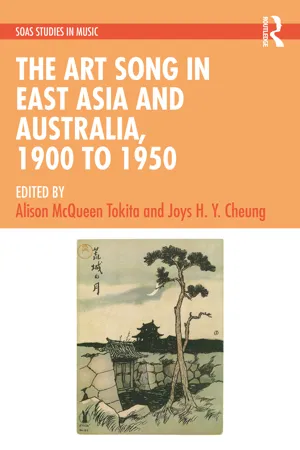
The Art Song in East Asia and Australia, 1900 to 1950
- 20 pages
- English
- ePUB (mobile friendly)
- Available on iOS & Android
The Art Song in East Asia and Australia, 1900 to 1950
About This Book
This book explores art song as an emblem of musical modernity in early twentieth-century East Asia and Australia. It appraises the lyrical power of art song – a solo song set to a poem in the local language in Western art music style accompanied by piano – as a vehicle for creating a localized musical identity, while embracing cosmopolitan visions. The study of art song reveals both the tension and the intimacy between cosmopolitanism and local politics and culture. In 20 essays, the book includes overviews of art song development written by scholars from each of the five locales of Japan, Korea, China, Taiwan, and Australia, reflecting perspectives of both established narratives and uncharted historiography. The Art Song in East Asia and Australia, 1900 to 1950 proposes listening to the songs of our neighbours across cultural and linguistic boundaries. Recognizing the colonial constraints experienced by art song composers, it hears trans-colonial expressions addressing musical modernity, both in earlier times and now. Readers of this volume will include musicologists, ethnomusicologists, singers, musicians, and researchers concerned with modernity in the fields of poetry and history, working within local, regional, and transnational contexts.
Frequently asked questions
Information
Table of contents
- Cover
- Half-Title
- Series
- Title
- Copyright
- Contents
- List of music examples
- List of figures
- List of contributors
- Acknowledgements
- Note on names and transliteration/romanization systems
- Note on eResources (complementary materials)
- 1 Art song as lyrical modernity in colonial and post-colonial contexts: Listening to each other’s songs
- 2 The rise of Japanese art song
- 3 Art song and musical/cultural identities in interwar Japan
- 4 Implications of poetic form for Japanese art songs
- 5 Conflict and synthesis of modern and traditional Japan in Hashimoto Kunihiko’s art songs
- 6 Nagai Ikuko and the “Movement for Singing in Japanese”
- 7 The birth and transformation of Korean art song
- 8 National identity and colonial modernity in gagok: Korean art songs of the Japanese colonial period
- 9 Metre and rhythm in Lee Sang-geun’s songs
- 10 Korean art song composers caught between Japan and South Korea and North Korea
- 11 A brief history of modern Chinese art song
- 12 Composition, commentary and collegiality in the translated modernity of early Chinese art song
- 13 Proved foundations with pentatonic inflections: “Longing for Home”, the first art song of Huang Zi and Wei Hanzhang
- 14 “I should have my own personality”: Identity negotiation in Tan Xiaolin’s art songs
- 15 “Taiwanese art songs” and “national languages”: Lu Chuan-sheng’s art songs of the 1940s
- 16 Competing voices in colonial Taiwan: Art song as a historical problem
- 17 Singing Chinese art song in Taiwan: The life journeys of two China-born vocalists
- 18 From singer to composer: The art songs of Koh Bunya (Jiang Wenye)
- 19 National identity and Australian art song (1901–1950)
- 20 A transnational perspective on musical modernity: The songs of Linda Phillips and Chen Tianhe
- Appendix
- Index